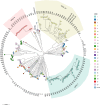Tracking the evolution of emerging serotypes and antibiotic resistance patterns in Streptococcus pneumoniae among Indian adults using high-throughput genome sequencing
- PMID: 41023908
- PMCID: PMC12481943
- DOI: 10.1186/s12879-025-11587-x
Tracking the evolution of emerging serotypes and antibiotic resistance patterns in Streptococcus pneumoniae among Indian adults using high-throughput genome sequencing
Abstract
Background: Streptococcus pneumoniae is a major cause of respiratory infections, particularly affecting children and the elderly. However, data on pneumococcal disease among Indian adults remain limited. This study investigated the epidemiology of S. pneumoniae from invasive and non-invasive sources in Indian adults using whole-genome sequencing (WGS).
Methods: A prospective study was undertaken in five hospitals of India between 2022 and 2023, including 254 S. pneumoniae isolates, 126 from invasive and 128 from non-invasive specimens. WGS was performed using the Illumina platform to determine serotypes, multi locus sequence types (STs), lineages, antimicrobial resistance (AMR), and virulence profiles. Antimicrobial susceptibility was assessed using the Vitek-2 system.
Results: A total of 37 serotypes, 53 Global Pneumococcal Sequence Clusters (GPSCs), and 128 STs (including 39 novel STs) were identified. Predominant serotypes included 19 F, 19 A, and 9 V, with GPSC1, GPSC10, and GPSC6 being the most common lineages. Vaccine coverage was estimated at 64% for PCV13 and 72% for PPSV23. Multidrug resistance (MDR) was observed in 70% of isolates, mainly among GPSC1, 10, and 6. Virulence genes were widely distributed, and pilus genes were more common in non-invasive isolates. Phylogenetic analysis showed GPSC1, 10, and 6 as dominant in both invasive and non-invasive sources.
Conclusion: The high prevalence of non-vaccine lineages, elevated MDR, and large number of novel STs reflect ongoing pneumococcal evolution in India, likely driven by recombination and capsular switching. These dynamics may reduce vaccine effectiveness. Continuous genomic surveillance is crucial to inform vaccine strategies and control pneumococcal disease in Indian adults.
Supplementary Information: The online version contains supplementary material available at 10.1186/s12879-025-11587-x.
Keywords: S. pneumoniae; AMR; GPSC; India; Serotypes; WGS.
Conflict of interest statement
Declarations. Ethics approval and consent to participate: The Study was approved by Kempegowda Institute of Medical Sciences independent ethics committee (Approval ID: KIMS/IEC/S06/2022 dated 22-July-2022). The study was conducted according to the guidelines and recommendations of Good Clinical Practice and the Declaration of Helsinki. Written informed consent was obtained from each participant or legal guardian as applicable. Consent for publication: Not applicable. Competing interests: The authors declare no competing interests.
Figures




References
-
- Centers for Disease Control Prevention. Pneumococcal Disease: Causes and How It Spreads. (2024). Available from: https://www.cdc.gov/pneumococcal/causes/index.html#cdc_causes_risk-risk-.... [Accessed on 12th July 2024].
-
- Torres A, Blasi F, Dartois N, Akova M. Which individuals are at increased risk of Pneumococcal disease and why? Impact of COPD, asthma, smoking, diabetes, and/or chronic heart disease on community-acquired pneumonia and invasive Pneumococcal disease. Thorax. 2015;70(10):984–9. 10.1136/thoraxjnl-2015-206780. Epub 2015 Jul 28. PMID: 26219979; PMCID: PMC4602259. - PMC - PubMed
-
- Wahl B, O’Brien KL, Greenbaum A, Majumder A, Liu L, Chu Y, et al. Burden of Streptococcus pneumoniae and Haemophilus influenzae type b disease in children in the era of conjugate vaccines: global, regional, and National estimates for 2000-15. Lancet Glob Health. 2018;6(7):e744–57. (18)30247-X. PMID: 29903376; PMCID: PMC6005122. - PMC - PubMed
-
- O’Brien KL, Wolfson LJ, Watt JP, Henkle E, Deloria-Knoll M, McCall N, Lee E, Mulholland K, Levine OS, Cherian T, Hib and Pneumococcal Global Burden of Disease Study Team. Burden of disease caused by Streptococcus pneumoniae in children younger than 5 years: global estimates. Lancet. 2009;374(9693):893–902. 10.1016/S0140-6736(09)61204-6. PMID: 19748398. - PubMed
Grants and funding
LinkOut - more resources
Full Text Sources

